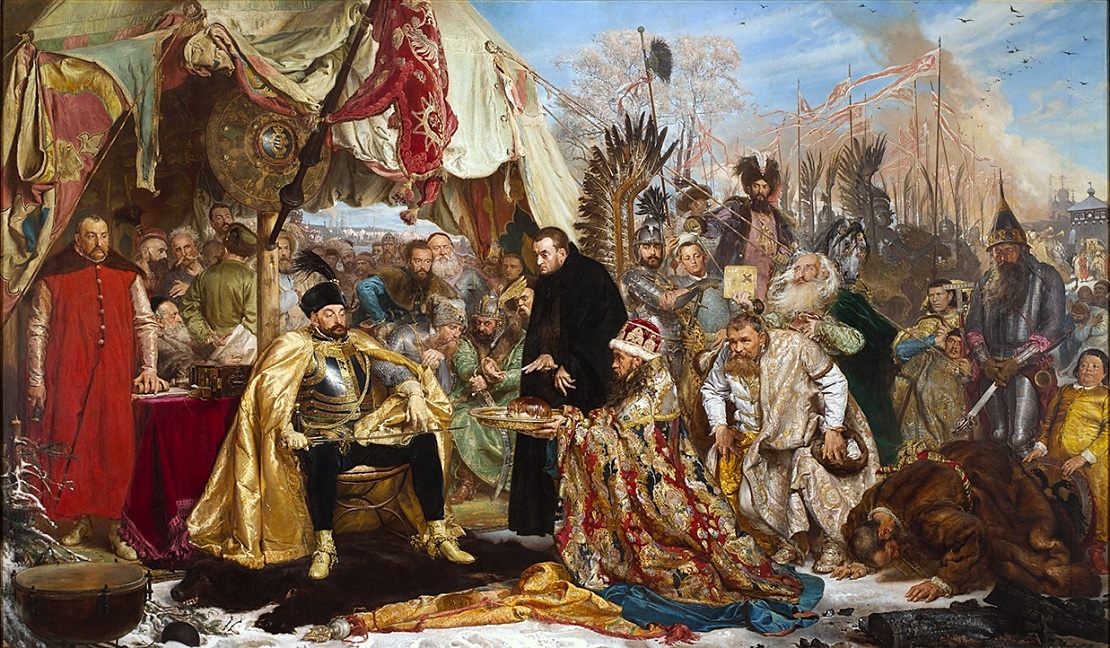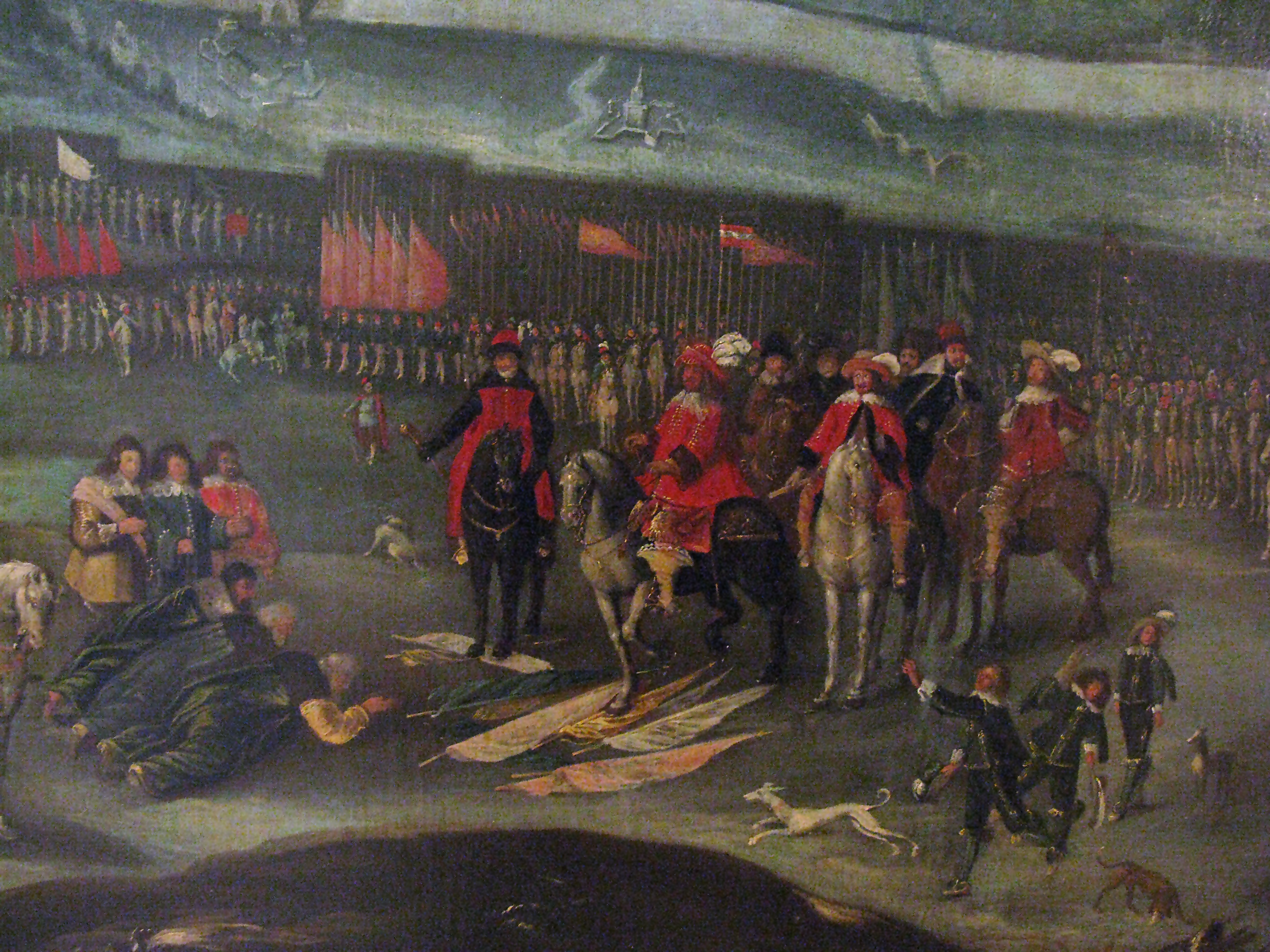|
Truce Of Jam Zapolski
The Truce or Treaty of Yam-Zapolsky (Ям-Запольский) or Jam Zapolski, signed on 15 January 1582 between the Polish–Lithuanian Commonwealth and the Tsardom of Russia, was one of the treaties that ended the Livonian War. It followed the successful Livonian campaign of Stephen Báthory, culminating in the siege of Pskov. The truce was concluded with help of papal legate Antonio Possevino and was signed for the Polish–Lithuanian Commonwealth by King of Poland and Grand Duke of Lithuania Stefan Batory and for Russia by Tsar Ivan the Terrible, and established a ten-year truce. In the terms of the treaty, Russia renounced its claims to Livonia and Polotsk but conceded no core Russian territories as Batory returned the territories his armies had been occupying (particularly, he gave up on the siege of Pskov and left the town of Velikiye Luki. The truce was extended for twenty years in 1600, when a diplomatic mission to Moscow led by Lew Sapieha concluded negotiations with ... [...More Info...] [...Related Items...] OR: [Wikipedia] [Google] [Baidu] |
Jan Matejko-Batory Pod Pskowem
Jan, JaN or JAN may refer to: Acronyms * Jackson, Mississippi (Amtrak station), US, Amtrak station code JAN * Jackson-Evers International Airport, Mississippi, US, IATA code * Jabhat al-Nusra (JaN), a Syrian militant group * Japanese Article Number, a barcode standard compatible with EAN * Japanese Accepted Name, a Japanese nonproprietary drug name * Job Accommodation Network, US, for people with disabilities * '' Joint Army-Navy'', US standards for electronic color codes, etc. * '' Journal of Advanced Nursing'' Personal name * Jan (name), male variant of ''John'', female shortened form of ''Janet'' and ''Janice'' * Jan (Persian name), Persian word meaning 'life', 'soul', 'dear'; also used as a name * Ran (surname), romanized from Mandarin as Jan in Wade–Giles * Ján, Slovak name Other uses * January, as an abbreviation for the first month of the year in the Gregorian calendar * Jan (cards), a term in some card games when a player loses without taking any tricks or scoring ... [...More Info...] [...Related Items...] OR: [Wikipedia] [Google] [Baidu] |
Lew Sapieha
Lew Sapieha ( lt, Leonas Sapiega; be, Леў Сапега or Lieŭ Sapieha; 4 April 1557 – 7 July 1633) was a nobleman and statesman of the Polish–Lithuanian Commonwealth. He became Great Secretary of the Grand Duchy of Lithuania in 1580, Great Clerk of the Grand Duchy in 1581, Crown Chancellor in 1585, Grand Chancellor from 1589 until 1623, Voivode of Vilnius in 1621, Great Lithuanian Hetman in 1623 and governor of Slonim, Brest and Mogilev. Sapieha is considered as a great political figure of the Commonwealth. A rich and powerful magnate, he was known for his wisdom as a statesman, lawyer and military commander, he was one of the greatest leaders of the Grand Duchy of Lithuania at the times of the Duchy's highest cultural flourishing. He was of Ruthenian ethnicity. Modern Belarusian sources interpret his Ruthenian heritage as Belarusian, however many facts presented by the modern Belarusian sources about the Grand Duchy of Lithuania are often distorted and unanimous ... [...More Info...] [...Related Items...] OR: [Wikipedia] [Google] [Baidu] |
Treaties Of The Polish–Lithuanian Commonwealth
A treaty is a formal, legally binding written agreement between actors in international law. It is usually made by and between sovereign states, but can include international organizations, individuals, business entities, and other legal persons. A treaty may also be known as an international agreement, protocol, covenant, convention, pact, or exchange of letters, among other terms. However, only documents that are legally binding on the parties are considered treaties under international law. Treaties vary on the basis of obligations (the extent to which states are bound to the rules), precision (the extent to which the rules are unambiguous), and delegation (the extent to which third parties have authority to interpret, apply and make rules). Treaties are among the earliest manifestations of international relations, with the first known example being a border agreement between the Sumerian city-states of Lagash and Umma around 3100 BC. International agreements were used in s ... [...More Info...] [...Related Items...] OR: [Wikipedia] [Google] [Baidu] |
Poland–Russia Relations
Poland–Russia relations ( pl, Stosunki polsko-rosyjskie, russian: Российско-польские отношения) have a long and often turbulent history, dating to the late Middle Ages, when the Kingdom of Poland and Kievan Rus' and later the Grand Duchy of Moscow struggled over control of their borders. Over centuries, there have been several Polish–Russian Wars, with Poland once occupying Moscow and later Russia controlling much of Poland in the 19th as well as in the 20th century, damaging relations. Polish–Russian relations entered a new phase following the fall of communism, 1989–1993. Since then, Polish–Russian relations have at times seen both improvement and deterioration. Historical Poland and Ancient Russia One of the earliest known events in Russian-Polish history dates back to 981, when the Grand Prince of Kiev, Vladimir Svyatoslavich, seized the Cherven Cities from the Duchy of Poland. The relationship between two by that time was mostly close ... [...More Info...] [...Related Items...] OR: [Wikipedia] [Google] [Baidu] |
Peace Treaties Of Russia
Peace is a concept of societal friendship and harmony in the absence of hostility and violence. In a social sense, peace is commonly used to mean a lack of conflict (such as war) and freedom from fear of violence between individuals or groups. Throughout history, leaders have used peacemaking and diplomacy to establish a type of behavioral restraint that has resulted in the establishment of regional peace or economic growth through various forms of agreements or peace treaties. Such behavioral restraint has often resulted in the reduced conflict, greater economic interactivity, and consequently substantial prosperity. "Psychological peace" (such as peaceful thinking and emotions) is perhaps less well defined, yet often a necessary precursor to establishing "behavioural peace." Peaceful behaviour sometimes results from a "peaceful inner disposition." Some have expressed the belief that peace can be initiated with a certain quality of inner tranquility that does not depend upo ... [...More Info...] [...Related Items...] OR: [Wikipedia] [Google] [Baidu] |
Timeline Of Russian History
__NOTOC__ This is a timeline of Russian history, comprising important legal and territorial changes and political events in Russia and its predecessor states. To read about the background to these events, see History of Russia. See also the list of leaders of Russia. Dates before 31 January 1918, when the Bolshevik government adopted the Gregorian calendar, are given in the Old Style Julian calendar. Centuries: 9th10th11th 12th13th 14th 15th 16th 17th 18th19th20th21stSee alsoFurther reading 9th century 10th century 11th century 12th century 13th century 14th century 15th century 16th century 17th century 18th century 19th century 20th century 21st century See also * Years in Russia, 1991–present ;Cities in Russia * Timeline of Grozny * Timeline of Kaliningrad * Timeline of Kazan * Timeline of Krasnodar * Timeline of Makhachkala * Timeline of Moscow * Timeline of Nizhny Novgorod * Timeline of Novosibirsk * Timeline of Omsk * Timeline of Ps ... [...More Info...] [...Related Items...] OR: [Wikipedia] [Google] [Baidu] |
Timeline Of Polish Diplomacy
This is a timeline of Polish history, comprising important legal and territorial changes and political events in Poland and its predecessor states. To read about the background to these events, see History of Poland. See also the list of Polish monarchs and list of prime ministers of Poland. __NOTOC__ Centuries: 5th 6th 7th 8th 9th10th11th 12th13th 14th 15th 16th 17th 18th19th 20th 21stSee also 5th century 10th century 11th century 12th century 13th century 14th century 15th century 16th century 17th century 18th century 19th century 20th century The Second Polish Republic (1918–39) Occupation of Poland (1939–45) Communist takeover, Polish People's Republic Democratic Republic of Poland 21st century See also ;Cities in Poland * Timeline of Białystok * Timeline of Gdańsk * Timeline of Kraków * Timeline of Łódź * Timeline of Lwów (formerly in Poland; now in Ukraine) * Timeline of Poznań * Timeline of ... [...More Info...] [...Related Items...] OR: [Wikipedia] [Google] [Baidu] |
List Of Treaties
This list of treaties contains known agreements, pacts, peaces, and major contracts between states, armies, governments, and tribal groups. Before 1200 CE 1200–1299 1300–1399 1400–1499 1500–1599 1600–1699 1700–1799 1800–1899 1900–1999 2000-Present Pending * Central American Free Trade Agreement * Free Trade Area of the Americas * Substantive Patent Law Treaty (SPLT) * WIPO Protection of Broadcasting Organizations * Anti-Counterfeiting Trade Agreement es, Acuerdo Comercial Anti-Falsificación , image = Anti-Counterfeiting Trade Agreement map (English).svg , image_width = 260 , caption = , type = Plurilateral agreement , date_drafted ... Notes References External links Treaty of Peace with Japan Signed at San Francisco on 8 September 1951Treaty of Peace Between Japan and India (1952) Treaty of Peace Between Japan and the Union of Burma (1954) Agreement Between Japan and ... [...More Info...] [...Related Items...] OR: [Wikipedia] [Google] [Baidu] |
Riga
Riga (; lv, Rīga , liv, Rīgõ) is the capital and largest city of Latvia and is home to 605,802 inhabitants which is a third of Latvia's population. The city lies on the Gulf of Riga at the mouth of the Daugava river where it meets the Baltic Sea. Riga's territory covers and lies above sea level, on a flat and sandy plain. Riga was founded in 1201 and is a former Hanseatic League member. Riga's historical centre is a UNESCO World Heritage Site, noted for its Art Nouveau/Jugendstil architecture and 19th century wooden architecture. Riga was the European Capital of Culture in 2014, along with Umeå in Sweden. Riga hosted the 2006 NATO Summit, the Eurovision Song Contest 2003, the 2006 IIHF Men's World Ice Hockey Championships, 2013 World Women's Curling Championship and the 2021 IIHF World Championship. It is home to the European Union's office of European Regulators for Electronic Communications (BEREC). In 2017, it was named the European Region of Gastrono ... [...More Info...] [...Related Items...] OR: [Wikipedia] [Google] [Baidu] |
Treaty Of Drohiczyn
The Treaty of Drohiczyn was concluded on 14 January 1581, during the Livonian War, between the city of Riga and the Polish–Lithuanian Commonwealth. The former Free imperial city Riga was added to Polish-Lithuanian Livonia. Its freedoms and privileges were in part confirmed in the ''Corpus Privilegiorum Stephanorum'', but also limited. One of its burgomasters was to be appointed ''Burggraf'', the Polish-Lithuanian official in town. Changes to the city's statutes required Royal approval. The Augsburg Confession was tolerated, but the city was deprived of the means to veto Royal interventions in its ecclesiastical affairs. Sources {{Campaigns and treaties of the Livonian War Livonian War 1581 in the Polish–Lithuanian Commonwealth Treaties involving territorial changes Drohiczyn Drohiczyn Drohiczyn () ( lt, Drohičinas/Drogičinas, be, Дарагічын, ua, Дорогочин, Дорогичин, ''Dorohochyn'', ''Dorohychyn'') is a town in Siemiatycze County, P ... [...More Info...] [...Related Items...] OR: [Wikipedia] [Google] [Baidu] |
Treaty Of Plussa
The Treaty or Truce of Plussa, Pljussa, Plyussa or Narva and Plusa (russian: Плюсское перемирие, sv, Stilleståndsfördrag vid Narva å och Plusa) was a truce between Russia and Sweden, which ended the Livonian War (1558-1583). The truce was signed on 10 August 1583 at the Plyussa River north of the city of Pskov. The truce was set to expire in 1586, but was extended in 1585-1586. According to the truce, Sweden kept the annexed Russian towns of Ivangorod (Ivanslott), Jamburg, Koporye (Kaprio) and Korela (Kexholm/Käkisalmi) with their uyezds, holding control over Ingria. Russia kept a narrow passage to the Baltic Sea at the estuary of the Neva River, between Strelka and Sestra Rivers. Upon the expiration of the truce in 1590, Russia resumed the war against Sweden. In 1593, Russia and Sweden resumed peace negotiations, which would last for two years. Finally, the two countries signed the 1595 Treaty of Teusina (Tyavzino). The aftermath was Sweden annexing ... [...More Info...] [...Related Items...] OR: [Wikipedia] [Google] [Baidu] |



.jpg)
